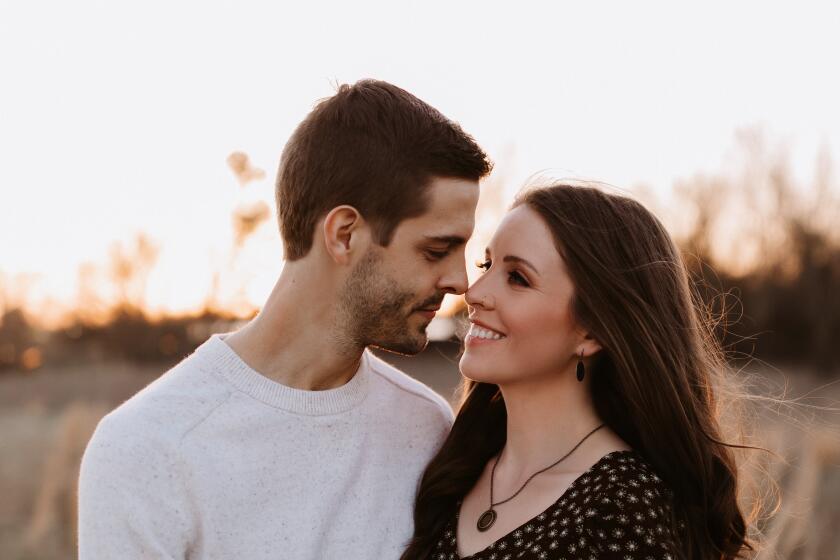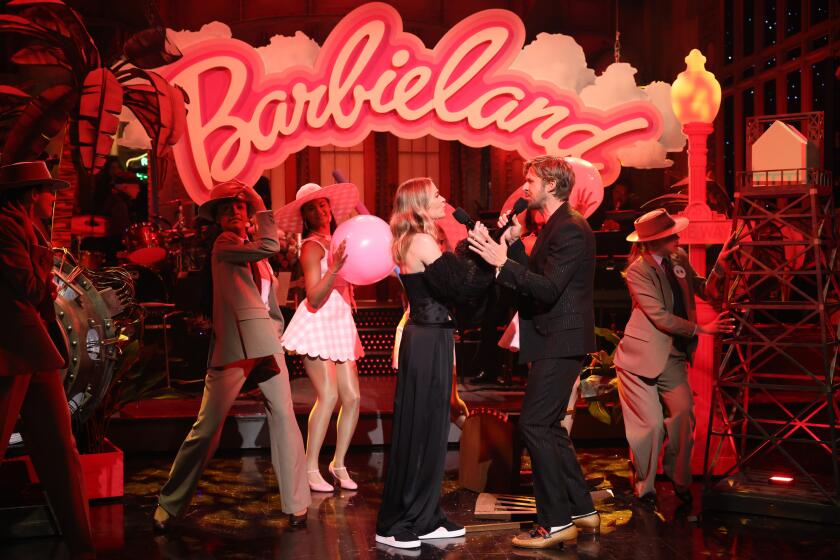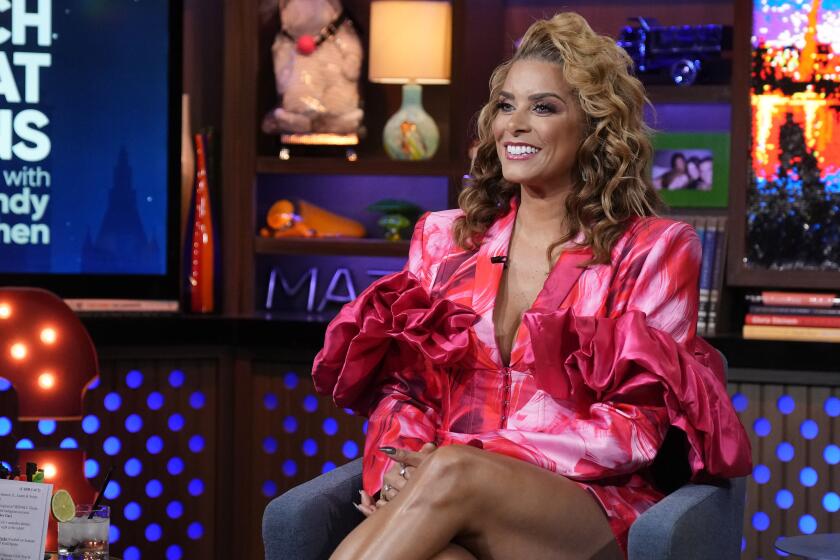A&E documentary ‘Biggie: The Life of Notorious B.I.G.’ takes a fascinating — and authorized — look at the rapper’s too-short story
From Tupac to N.W.A, the West Coast has had its fair share of hip-hop documentaries and biopics. Now it’s the East Coast’s turn.
“Biggie: The Life of Notorious B.I.G.” chronicles the short life of Brooklyn rapper Christopher Wallace in a three-part A&E documentary special that airs in its entirety Monday.
Biggie has gone down in rap history as a rare talent who changed the game with his rise to fame in the mid-’90s, despite the fact that he made only two studio albums before his death at the age of 24.
He was shot and killed in a still-unsolved homicide outside L.A.’s Petersen Automotive Museum in March 1997, six months after his former friend and nemesis, rapper Tupac Shakur, was killed in a similar drive-by shooting on the Las Vegas Strip.
Twenty years after his demise, the first authorized biography of the rapper opens with news clips about the shooting, but quickly pulls the story back to Brooklyn and the streets where Christopher Wallace was raised.
He rapped about those streets over his short career and director Mark Ford’s story of Biggie becomes the story of Brooklyn hip-hop. It chronicles that critical juncture when the genre went from mix-tape notoriety to the top 10 on the success of artists such as Biggie, Jay-Z, Nas and Bad Boy Records owner/producer Sean “Diddy” Combs.
All are interviewed here, along with Biggie’s widow, R&B singer Faith Evans, his crew the Junior M.A.F.I.A., and music journalists such as former Los Angeles Times writer Cheo Hodari Coker, who co-wrote the screenplay for the 2009 biopic “Notorious.”
Biggie’s mother, Voletta Wallace, reveals his early life as a boy who hardly knew his father. She provides photos of a chubby kid with glasses riding a banana-seat bike on cracked sidewalks, or looking utterly uncool while goofing with buddies on brownstone stoops.
He was a class clown who came of age on the streets of Bed-Stuy, and was dealing drugs by the time he was 13. He went to great lengths to hide what he was doing from his mother.
Voletta Wallace recalls cleaning her son’s room, and being disgusted when she found an old plate of petrified mashed potatoes. “I threw that dried-up plate of white stuff away,” she explains.
Cut to an interview with Biggie, in which he recalls his mom throwing away the crack cocaine he was working on because she thought it was old food. He explains he had to dig it out of the garbage, and rinse the barbecue sauce off before repackaging it for sale.
Wallace says she had no idea those “potatoes” were drugs until she heard Biggie’s taped interview — after his death.
“Biggie: Life of the Notorious B.I.G.” provides detail and depth on the life of an artist whose story hasn’t been as exhaustively explored as Tupac’s or N.W.A.’s.
The new information makes up for sloppy editing — scenes of his old crew and Evans talking about good times over plates of fried chicken at his favorite restaurant feel forced. It doesn’t help that nearly every time Biggie talks or raps, the film provides subtitles.
Yes, Biggie had a lisp and slurred — speech impediments that should have ensured that he’d be laughed out of early freestyle competitions, let alone be a viable candidate for a record contract. But he turned those deficits into individualized, artistic strengths.
As Jay-Z explains, “He would take things that you’d use against him, and just defuse it [raps Biggie lyrics] ‘Black and ugly as ever, however, I stay Coogi down to the socks.’ Now you can’t use it. He just defused it.” The corny, animated subtitles accompanying his lyrics undercut those points.
The tone of the film turns tense in the last third, when the story of his rise to fame after meeting Combs and mentoring the careers of Lil’ Cease and Lil’ Kim gives way to a deadly East Coast-West Coast feud.
Early clips of Biggie hanging with Tupac, freestyling for fun, show a very different relationship between the men than music history affords. Their beef is often associated with the tensions between rap crews and fans on opposite coasts. The documentary, however, contends that much of the narrative was drummed up by the media, despite Tupac’s provocation on record.
A vintage Tupac interview in the film shows him describing Biggie with great warmth: “He has a great sense of humor. In his interviews he seemed so angry, and at the same time so charming.”
The two men fell out, according to the A&E special, when Tupac was shot during an attempted robbery at a studio in New York where Biggie was recording. Tupac felt he was set up by the Bad Boy crew.
Tupac was signed with Death Row Records, which was run by the feared Marion “Suge” Knight, who reveled in the animosity, ratcheting up the tension during a now-infamous speech at the Source Awards in 1995 where he directly insulted Combs. (Knight is currently in prison awaiting trial on charges of murder, and was recently indicted for threatening to kill “Straight Outta Compton” director F. Gary Gray.)
The media seized upon the rivalry. In the documentary, Biggie talks about being paranoid and scared for his life. Interview clips with Biggie and Tupac show them downplaying the beef. Those who knew Biggie say he tried to avoid and even defuse the conflict up until the night he was killed.
Combs says their decision to go to L.A. for the Soul Train Awards, and an after-party at the Petersen museum, was a stupid one. They thought the tension had died down. They were wrong.
A former LAPD officer interviewed in the film says he wholly believes Knight was involved in Wallace’s slaying. It’s an explosive comment sure to add to the ongoing discussion and conspiracy theories surrounding who killed Biggie and Tupac.
By its end, “The Life of Notorious B.I.G.” returns to where it started, Brooklyn: Crowds pouring into the street for his funeral procession, the murals of him wearing a crown — at least one of which still graces the side of a building 20 years after his death.
What kind of person could take another person’s life, asks his mother after she visits the mural, and revisits the places where they once lived as mother and son. “Murder takes hatred to kill someone,” says Voletta Wallace. “I pity the person who killed my son. I have his beautiful memories. [The killer] doesn’t have that.”
And now fans have this intimate and detailed film to remember him by.
‘Biggie: The Life of Notorious B.I.G.’
Where: A&E
When: 8 p.m. Monday
Rating: TV-14-DLV (may be unsuitable for children under the age of 14 with advisories for suggestive dialogue, coarse language and violence)
More to Read
The complete guide to home viewing
Get Screen Gab for everything about the TV shows and streaming movies everyone’s talking about.
You may occasionally receive promotional content from the Los Angeles Times.







